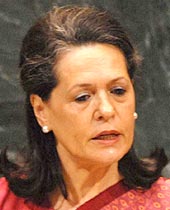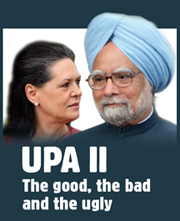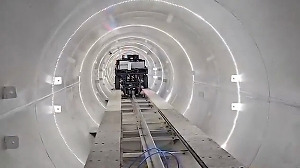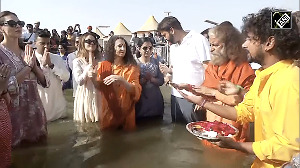 There is a lack of connect between the Congress president and Prime Minister Manmohan Singh in UPA-2. But Sonia Gandhi has ensured that the government does not waver from her pet policies -- NREGA, RTI etc, notes Neerja Chowdhury
There is a lack of connect between the Congress president and Prime Minister Manmohan Singh in UPA-2. But Sonia Gandhi has ensured that the government does not waver from her pet policies -- NREGA, RTI etc, notes Neerja Chowdhury
When the Congress took over at the head of a coalition in 2004, after being out of power for eight years, the credit for the victory went mainly to party President Sonia Gandhi. She had taken a demoralised party to victory.
In the winter of 2003, Congressmen were openly saying that the party might not hit the 100 mark in the Lok Sabha election. The party had lost several Hindi heartland states and the morale was low.
A determined Sonia stitched up alliances with regional parties. The picture of her walking to the house adjacent to 10, Janpath, where Ram Vilas Paswan lived, lingered for a long time. It was no easy decision, for the Congress, as the country's grand old party, was used to ruling on its own.
Barring a short stint in the early 1990s of the party running a minority government during the initial months of P V Narasimha Rao's premiership, 2004 was the first time that the Congress headed a coalition government at the Centre. It was under Sonia's leadership that the Congress made the transition from majority rule to being a coalition player.
When she entered active politics in 1998, doubts were being expressed about her ability to manage so many political players straddling the Indian scene. And Indian political decisions hinge as much on relationships as on policies and programmes.
Sonia also hit the road in early 2004 and visuals of her walking alongside emaciated Dalits, or putting her arm around a skinny, wizened woman stuck in the mind in the backdrop of the shrill National Democratic Alliance's Shining India campaign.
 Given her foreign origins, and as the inheritor of the Nehru-Gandhi legacy, Sonia was from the beginning conscious that she must acquire for herself and for the Congress a left-of-centre image, even as the economic reforms process went ahead.
Given her foreign origins, and as the inheritor of the Nehru-Gandhi legacy, Sonia was from the beginning conscious that she must acquire for herself and for the Congress a left-of-centre image, even as the economic reforms process went ahead.
When she decided not to accept the country's prime ministership, which was within her grasp, with both the Congress and the United Progressive Alliance parties having endorsed her candidature, it buried the issue of her foreign origins for all time, giving her acceptability both as Congress president and UPA chairperson.
Throughout the tenure of UPA-1, she played the role of a defuser. Whenever the prime minister ran into trouble with the Left -- she established a personal rapport with leaders like Somanth Chatterjee and Sitaram Yechury -- he turned to her for ending the standoff, as happened on the issue of disinvestment of the navratnas which was put on the backburner, after her mediation.
She kept close tabs on the government and as the prime minister himself used to say she looked after the political decisions and he of economics and administration -- if such a division can really be made. She took interest in appointments and postings not just of politicos to committees or governorships but also of officials, and the presence of her confidante Pulak Chatterjee in the Prime Minister's Office facilitated this.
The civil society led, 'social think-tank', the National Advisory Council headed by her, till aborted by the office of profit controversy, gave her authority to give direction to the government and push it towards a welfarist (National Rural Employment Guarantee Act) and rights (Right to Information) agenda.
There are several differences between the Sonia Gandhi in UPA-1 and the Sonia Gandhi in UPA-2. For a start, she does not seem to be as proactive or as hands-on in the affairs of the UPA-2 government in a daily sort of a way, as she was during UPA-1.
She was in fact criticised for devoting too much attention to government affairs at the cost of the party, with even the reorganisation of the All India Congress Committee not taking place for months and years. This time there is no Pulak Chatterjee briefing her on a daily basis.
Today's Sonia intervenes with macro sweeps when needed, whether it is to insist on food security, and the debate is now not just on the number of Below Poverty Line families but on the ambit of the proposed legislation and whether the government would build in the nutrition needs of women, children and the deprived communities into the law that Sonia wants and she has written to the prime minister on this, or just follow a minimalist approach of giving 25 kgs of grain at Rs 3 a kg -- that the prime minister seems to favour.
In recent months she has moved through the party, be it in opposing the Sharm-el-Sheikh joint declaration, or the passage of the Nuclear Liability Bill, referred now to standing committee, which is viewed with disquiet, even in the Congress, as it is felt that the American nuclear commercial interests are getting more weightage than India's security safeguards.
The lack of a connect between her and the prime minister in UPA-2 has been evident in their body language and this was apparent in the just concluded Budget session of Parliament.
The prime minister sat alone in a corner during the cut motion debate, looking expressionless, talking to no one, and no one walking up to him to talk to him, whereas Finance Minister Pranab Mukherjee sitting next to him turned frequently to Sonia on the other side, laughing and chatting.
So also was the case after a discussion in the House on the caste census, Sonia, Pranab Mukherjee and some other Congress leaders stood around discussing and the prime minister stood at one end, not central to the circle leading the discussion.
Whether as a cause or an effect, Manmohan Singh has tended to concentrate more on foreign policy, and has undertaken foreign trips even when Parliament was in session. In UPA-2 the positions taken by the prime minister and by Sonia Gandhi stem from their different priorities.
Dr Singh would like to pursue his unfinished agenda of reforms and be remembered for making headway on improving Indo-Pak relations and resolving the Kashmir tangle.
Rahul Gandhi's presence as a serious player is an additional factor on the horizon in UPA-2 and Sonia is more aware of the need to rebuild the party, and ready it for him for 2014 or whenever he is prepared to take over.
She knows the party has to do well in the four important states that are coming up for elections in the next two years and these happen to be states which not only account for 200 Lok Sabha seats but also ones where the Congress did not add to much.
It goes without saying that it will be difficult for Rahul to take over unless the party revives in these states. That is why the polls in Bihar (later this year), in West Bengal and Tamil Nadu next year and in Uttar Pradesh in 2012 become so critical for the Congress.
Rahul Gandhi's 'ekala chalo' mantra had paid the party rich dividends in UP in the Lok Sabha polls. But the government's compulsion of passing the Finance Bill compelled it to come to an understanding with Mayawati's Bahujan Samaj Party in Parliament and diluted the go-it-alone signals, though Rahul is trying to correct this impression.
Sonia's decision to revive the NAC -- though she has taken time over selecting its members -- is to ensure that the party does not move away from its social and pro-poor agenda -- NREGA, loan waiver to farmers and the RTI which paid the party rich dividends in the 2009 election.
One of the things the NAC is expected to take up first is the food security bill. If the Raisina Hill grapevine is to be believed, there has been to-ing and fro-ing between her and the prime minister on this. The prime minister on the other hand -- as also the finance minister -- would like to move towards fiscal consolidation.
Sonia Gandhi would clearly like to create categories of support for the party in the coming months, like women, youth and minorities, which go beyond the caste equations which vary from state to state.
Her insistence on the Women's Reservation Bill, a promise made by the party and the bill was passed by the Rajya Sabha, was meant to be a step in that direction. The trouble was that she really did not have the support of most of the male members of her party, no matter what their rhetoric, and many of them were shooting off the shoulders of Mulayam Singh Yadav and Lalu Yadav.
The Yadavs cleverly managed to rope in Muslim leaders to demand, like them, a quota within the quota. The Congress has put the bill on the back burner for the moment not only to ensure the support of the two Yadavs and Mayawati who also refused to support the bill, but also because it does not want to do anything to antagonise the minority community.
The Congress has also been speaking with many voices on how to combat the Naxal onslaught which is the biggest challenge faced by UPA-2 today, like the need for air power, being sought by the home minister who publicly talked about having been given only a 'limited mandate'.
The armed forces have been used over the years to quell insurgencies in the northeast, but to use them in the heart of mainland India, no matter how limited their use, would be another ball game, and send its own signal, both nationally and internationally.
It is for all these reasons that the government versus party tensions are surfacing that much more in UPA-2 than they did last time. Already party persons are openly seeing the Congress party in the role of as a senior leader put it, "constructive opposition" to the government, as and when needed.








 © 2025
© 2025